How to Take Care of a Ladybug
This article was co-authored by wikiHow Staff. Our trained team of editors and researchers validate articles for accuracy and comprehensiveness. wikiHow’s Content Management Team carefully monitors the work from our editorial staff to ensure that each article is backed by trusted research and meets our high quality standards.
There are 9 references cited in this article, which can be found at the bottom of the page.
wikiHow marks an article as reader-approved once it receives enough positive feedback. This article received 91 testimonials and 91% of readers who voted found it helpful, earning it our reader-approved status.
This article has been viewed 733,848 times.
You might not know it, but ladybugs make good pets—they’re cute, quiet, easy to catch, and don’t take up a lot of space. Though these beautiful bugs are the happiest roaming free, you can easily create a comfortable habitat for them in your own home. All you need is a large enclosed container full of sticks and rocks to replicate their natural environment and enough food and water to meet their basic needs. It’s a good idea to release your captive ladybugs back into the wild come fall so that they can hibernate and mate to produce a new generation.
What Do Pet Ladybugs Eat?
Keeping a ladybug as a pet in a bug box or terrarium can help kids understand the life cycle of an organism through observation. It is important to keep the atmosphere moist for them, either by spraying the living environment or by putting a damp paper towel inside. Their diet can include small insects, fungi, or fruit, but what you will feed the ladybug depends on the type you are keeping.
Most ladybugs will eat aphids. These tiny insects are pests to gardeners because they eat through plant leaves, destroying foliage. Purchase aphids at any pet-supply store and put them in your ladybug container so they can feast on them.
Other insects
Most ladybugs will eat other small insects like mites, white flies, and scale insects. These are also pests to plants. Make sure any insects you feed your ladybugs are smaller than it.
Epilachninae, a sub-species of ladybugs, are small round beetles that are orange-colored and spotted. They are considered to be the vegetarians of the ladybug world, since they eat fungi like mushrooms and mildew. Some even eat leaves.
What Do Ladybugs Eat?
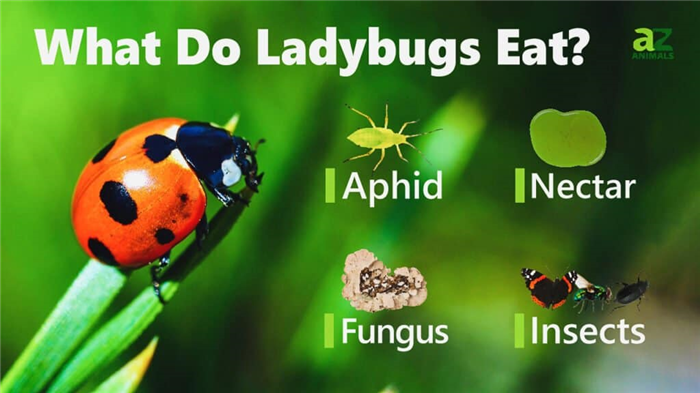
Ladybugs predominately eat aphids, which are small bugs
Ladybugs are small round red insects with black spots. They can be other colors, like orange, yellow and black, but the most familiar species is the seven-spotted ladybug which is red. Ladybugs are sometimes called ladybird beetles or lady beetles; they got their name from farmers who would pray to the Virgin Mary for protection for their crops. When aphids and other pests invaded their crops, ladybugs came in and ate the bugs and saved the crops. Ladybugs are still farmer’s best friends and provide an important role in controlling aphids and other bugs. So we know they eat aphids, what else do ladybugs eat?
How do Ladybugs hunt?
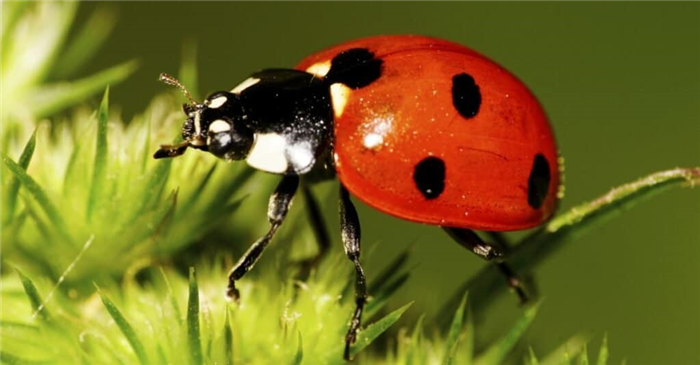
Caucasian red seven-spotted ladybug with black and white spots on the elytra, long legs, antennae has risen on legs in green inflorescence
Out in a field of alfalfa a colony of 1,000 ladybugs munches away on tiny aphids that are on the leaves. Aphids are wingless, slow-moving bugs so there is no complex hunt involved. No hiding waiting for an unsuspecting victim to wander by. The ladybug essentially flies in, finds a spot full of aphids and dinner is served. Aphids will use gravity to fall off the leaves to escape, but since ladybugs can fly they can still typically find them.
What do Ladybugs eat?
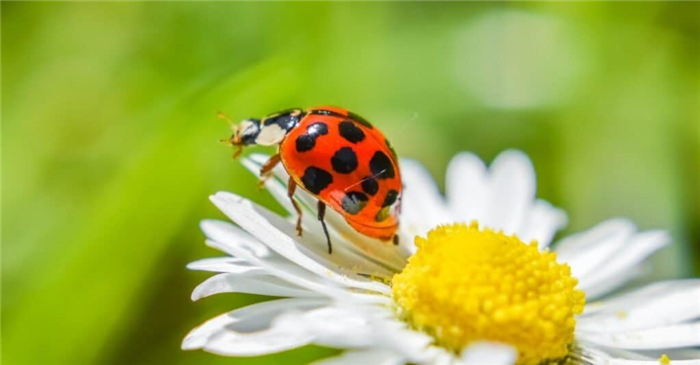
A ladybug on a daisy flower. Female ladybugs can eat as many as 75 aphids in one day, they also like to eat scale, mealybugs, and spider mites
Ladybugs primarily eat aphids, a type of small, wingless bugs. This is across species, habitat and location. But with 5,000 species of ladybugs there is some variation. There are some species that feed on pollen and nectar, other species feed on plant parts like the stems. Some species, if they can’t find aphids or aphids are absent, can feed on fungus and mildew. Another group will feed on mites. Most ladybugs will eat insect eggs if they come across them as well.
A complete list of what Ladybugs eat:
- Aphids
- Plant-eating bugs
- Mites
- Pollen
- Nectar
- Mealybugs
- Insect eggs
- Mildew
- Fungi
- Fruit flies
- Plants (some species)
Adult ladybugs eat all day long, they are less active at night, and can consume up to 5,000 aphids in their lifetime! The lifespan of a ladybug is 1-2 years.
What do baby ladybugs (larvae) eat?
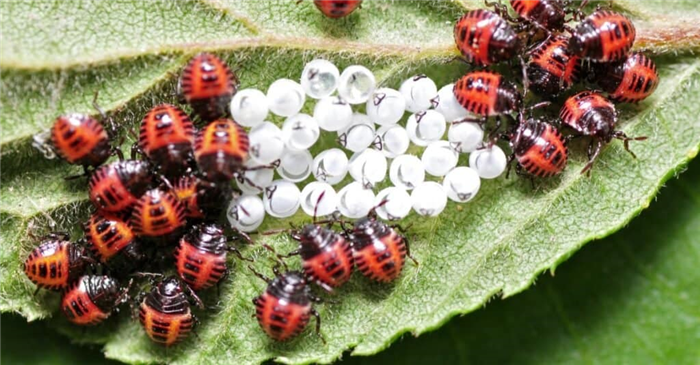
Ladybug larvae and eggs on a leaf.
Mother ladybugs lay their eggs next to aphids so when the larvae hatch they are essentially hatched inside a full service restaurant. The aphids are right there and the larvae can begin feeding right away and do they ever. They consume large amounts of aphids over the next few weeks before entering the pupal stage and then the adult stage. Ladybug larvae can consume 300-400 aphids over a 2-3 week period!
What eats ladybugs?
Their bright colors and spots are a reminder to predators that, like a bad tasting jelly bean, they taste awful, so don’t eat them! They have glands in their joints that give off an offensive smell and yet some animals still prey on the ladybugs. What eats ladybugs? The most common predator is birds that can swoop down and eat them, but depending on their habitat they can be eaten by frogs, dragonflies and spiders.
What do ladybugs eat in space…wait, what?
NASA performed an experiment with ladybugs and aphids in space! In 1999, a group of astronauts brought four ladybugs with them on the space shuttle to see how gravity would affect the aphids ability to escape from the ladybugs. On Earth, aphids simply fall off leaves, using gravity, to escape from hungry ladybugs. What would happen in space, in a zero gravity environment? Teachers and students were encouraged to do similar experiments in their own classrooms and compare results. Did the aphids adapt? Not in this experiment. The ladybugs survived and ate the aphids. But the aphids did leave a legacy of being the first aphid astronauts!
Share this post on:
Cindy Rasmussen
I’m a Wildlife Conservation Author and Journalist, raising awareness about conservation by teaching others about the amazing animals we share the planet with. I graduated from the University of Minnesota-Morris with a degree in Elementary Education and I am a former teacher. When I am not writing I love going to my kids’ soccer games, watching movies, taking on DIY projects and running with our giant Labradoodle “Tango”.
Ladybird / ladybug
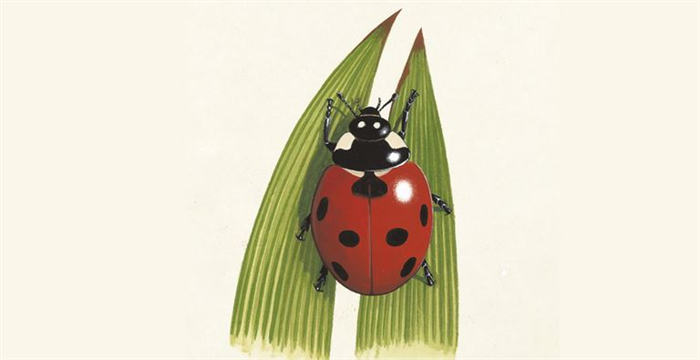
Ladybird / Ladybug
- Scientific name: Two-spot ladybird, Adalia bipunctata / Seven-spot ladybird, Coccinella septempunctata
- Type: Insects
Key information
Among the best-known and most well-loved beetles, ladybirds (also known as ladybugs) are easy to recognise. The most familiar have bright red elytra (wing cases) with black spots, while other common species such as black and yellow ladybirds, white and brown ladybirds, or even striped ladybirds.
The most common species are the two-spot and larger seven-spot ladybirds, although about 40 others can also be found in the British Isles.
Ladybirds are brightly coloured, warning predators of their bitter taste, which helps survival. They are also able to exude a pungent fluid to ward off ants, birds and people.
During the winter adults hibernate in cracks, crevices and leaf litter and emerge in April to find a mate. Females lay eggs that hatch after about four days, depending on the temperature.
The steely-blue larvae with creamy-yellow spots do not resemble the adults. They eat aphids voraciously. After several moults over the course of a few months, they emerge as adults to feed for a few weeks before seeking a sheltered spot to hibernate.
What they eat:
Adult ladybirds and larvae feed on aphids and small insects.
Natural habitats: Bog garden Bug box Flower border Hanging basket Hedge Herb garden Meadow area Nettle patch Patio Shed Shrub Window box Woodland area
How Do I Prevent a Ladybug Infestation?
Asian lady beetles are attracted to bright, contrasting colors in places that get a lot of sun. For houses, this often means a white, south-facing window frame or wall that contrasts with darker surroundings. The best way to prevent a ladybug infestation is to seal up the cracks and crevices around windows in the summer, before the ladybugs even get a chance to enter. A less permanent (and less aesthetically pleasing) solution is to block the windows with dark trash bags or curtains.
Strong scents can also deter ladybugs, so spritzing window and door frames with vinegar, a weak lemon spray, or mint oil may be successful. Scented candles or cloves of garlic placed near potential ladybug entry points may also work. (Avoid garlic if you have household pets, though, as it can be toxic to dogs and cats!)
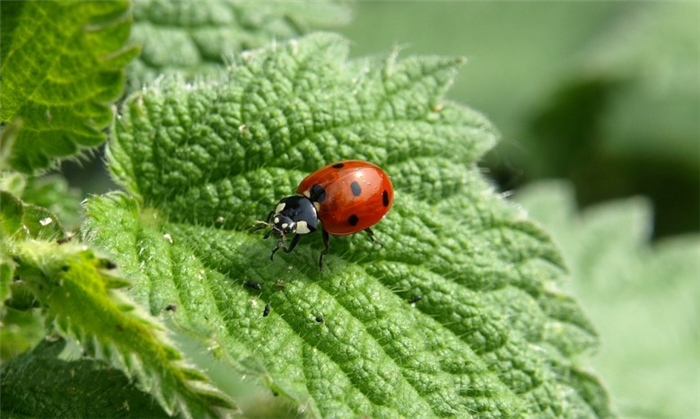
A seven-spotted ladybug rests placidly on a leaf.
In the spring, ladybugs awaken from their deep sleep and begin to migrate outside again. It’s at this point that people encounter lost ladybugs who’ve forgotten the way out and instead end up trapped inside, often dying along windowsills. Living ladybugs should be released outside so that they can get back to work on your garden.
Other than being superficial pests, Asian lady beetles aren’t troublesome house guests, as they don’t eat or damage anything during their winter slumber and tend to leave as soon as spring arrives. However, when startled, they can produce a yellowish, unpleasant-smelling liquid that can stain furniture and clothing. This is a defense mechanism called reflex bleeding, in which the ladybug bleeds from its knees to make it smell and taste unappealing to predators. Ladybugs also have the capacity to bite when harassed, but they usually prefer to just flee instead.
